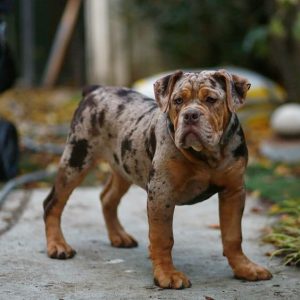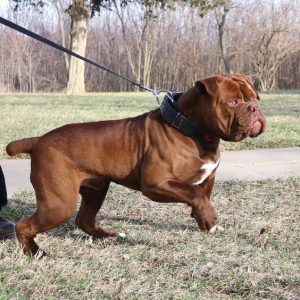Old English Bulldog
The Old English Bulldog is a breed of dog known for its distinctive appearance and historical significance. Originally developed in England, this breed has a muscular and robust build with a distinctive wrinkled face and a pushed-in nose. They were traditionally used for bull-baiting, a now-banned sport where dogs would engage with bulls in a confined area.
In recent times, the Old English Bulldog has seen a resurgence in popularity as a companion animal. However, it’s important to note that they can have certain health concerns due to their unique physical features, such as breathing difficulties because of their short muzzle. Responsible breeding practices and regular veterinary care are crucial to ensure their well-being.
These dogs require moderate exercise and mental stimulation to stay happy and healthy. Their short coat is relatively low-maintenance, needing occasional brushing to keep it clean and shiny. Regular check-ups, a proper diet, and an appropriate exercise routine are essential for the overall health and longevity of the Old English Bulldog.
The Origins and History
The history of the Old English Bulldog is deeply intertwined with England’s past, where it was originally bred for bull-baiting—a brutal sport where dogs would confront bulls in a test of strength and tenacity. Over the years, this breed transitioned from a working dog to a loyal and cherished companion, gaining popularity for its adaptable nature and affectionate demeanor. Discover more about German Shepherd Puppies| The Origin and Characteristics
The Ancestral Roots
The Old English Bulldog’s roots can be traced back to the ancient Molossian dogs, known for their formidable strength. These dogs were brought to England by various groups, eventually leading to the development of the breed we know today.
Bull-Baiting Era
During the 18th century, the Old English Bulldog gained notoriety for its role in bull-baiting. The breed’s powerful build and unwavering determination made it a formidable adversary in this dangerous sport.
Transition to a Companion
As attitudes toward animal welfare changed, bull-baiting was banned in 1835. The Old English Bulldog faced extinction, but dedicated breeders worked to refine its characteristics, leading to the emergence of a more gentle and affectionate temperament.
Characteristics and Appearance
The Old English Bulldog boasts a unique and recognizable appearance, characterized by its muscular frame, loose skin, and expressive face. Read more about Golden Retriever Puppies: Joyful Additions to Your Family
The Robust Build
With a stout body and a strong, sturdy frame, the Old English Bulldog carries an air of confidence and power. Its wide chest and muscular limbs showcase its athletic heritage.

The Iconic Face
The breed’s face is adorned with loose, wrinkled skin and a distinctive pushed-in nose. This characteristic “snub nose” gives the Old English Bulldog its unmistakable charm.
Coat and Color Variations
Old English Bulldogs showcase a variety of coat colors and patterns, from solid whites and brindles to fawn and red. Their short, smooth coats require minimal grooming.
The Heartwarming Temperament
Beyond its physical attributes, the Old English Bulldog wins hearts with its affectionate and friendly disposition.
Family Bonding
Known for their love of human company, Old English Bulldogs thrive when they’re included in family activities. They form strong bonds with their owners, making them excellent companions for households of all sizes.
Playful Nature
Despite their past as working dogs, Old English Bulldogs have retained a playful and sometimes goofy nature. They are known to engage in amusing antics that leave their owners entertained and delighted.
Care and Maintenance
Ensuring the well-being of your Old English Bulldog involves proper care, attention, and understanding of their unique needs.
Physical Exercise
Regular exercise is vital for maintaining the breed’s physical and mental health. Daily walks and interactive play sessions help prevent obesity and keep their spirits high.
Grooming Basics
While their short coats require minimal grooming, routine brushing helps remove loose hair and keeps their skin healthy. Cleaning their facial wrinkles is essential to prevent any irritation.

Conclusion
In conclusion, the Old English Bulldog is not just a breed; it’s a faithful companion that embodies strength, loyalty, and affection. Through a journey that spans centuries, this breed has evolved from its bull-baiting origins to become a cherished member of countless families. With their unique appearance, charming temperament, and devoted nature, Old English Bulldogs continue to capture the hearts of dog lovers around the globe.
FAQs
Are Old English Bulldogs good with children?
Absolutely! Old English Bulldogs are known for their gentle and affectionate nature, making them great companions for families with children.
Do Old English Bulldogs require a lot of exercise?
While they have a sturdy build, Old English Bulldogs have moderate exercise needs. Daily walks and playtime are usually sufficient to keep them happy and healthy.
Are Old English Bulldogs easy to train?
Yes, they are intelligent and eager to please, which makes training relatively easy. Consistent positive reinforcement methods work best.
Are Old English Bulldogs prone to health issues?
Like all breeds, Old English Bulldogs have certain health considerations, such as potential breathing difficulties due to their pushed-in noses. Regular veterinary check-ups are important.
Do Old English Bulldogs get along with other pets?
Yes, with proper socialization, Old English Bulldogs can coexist peacefully with other pets. Early exposure and training are key to fostering positive interactions.
